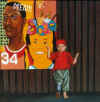
VII
Second fall
Landmines
Against the
background of a drab dark wall a brightly-painted poster clamors out
publicity about basketball champs with faces aglow and athletic
builds. All this is only a brightly-colored dream for the child in
the foreground: he has had a leg blown off by a landmine. |
![]()
| A reflection by Brother Bernard Couvillion |
In northern Uganda I asked why there seemed to be so many children amputees missing one or both legs or hands. The answer came in a word: landmines. The rebel terrorists who arm themselves in Sudan return to plant mines in their own villages, on pathways, roads and bridges. Whatever the location, the intention is the same: to intimidate. The
International Committee of the Red Cross in Geneva estimates that
more than two million mines were laid last year. Only 100,000 were
cleared. Every month two thousand civilians are killed or maimed by
mines, about 40 % of them children under the age of 15. Cambodia has more mines than children—two for every child. Children are
particularly vulnerable to mines because they are closer to the
center of the blast and because of their curiosity and love of play.
During conflicts they have been trapped indoors or underground.
“As soon as the fighting is over,” explains a Unicef
officer, “they are desperate to get out and have a look
around. All they want to do is to breathe in the fresh air, to run
and play and live a normal life again. Try telling them they can’t
do that.” Mines, with their different shapes and colors, are enticing. Kurdish
children look for mine parts to build toy cars. The tiny
“butterfly mines,” designed to deliver a small blast that will
only blow away a hand or a foot, are often dropped from the air.
Children in some places call them “green parrots.” The physical wounds inflicted by mines are all too obvious; the psychological ones are less so. Children who grow up in a minefield often suffer depression, weight loss, inability to concentrate, sleeping difficulties, hyperactivity, and failure to thrive. Then there is the terrible prospect of those who will grow up to perpetuate the violence they have experienced. (www.oneworld.org) |
![]()
| We give voice to the prayer
of children stricken by landmines |
Have mercy on me, God, have mercy for in you my soul has taken refuge. In the shadow of your wings I take refuge until the storms of destruction pass by. I call to God the Most High. May he shame those who assail me. May God send his truth and his love. My soul lies down among lions, who would devour the children of men. Their teeth are spears and arrows, their tongue a sharpened sword. They laid a snare for my steps, my soul is bowed down. They dug a pit in my path. . . . O God, arise above the heavens; may your glory shine on earth! |
![]()